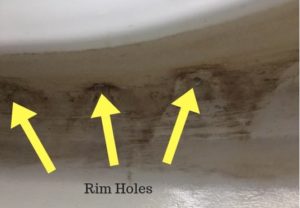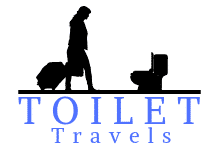You use the toilet multiple times each day. You know how to flush the toilet, but if something goes wrong you’re in trouble.
If you’re handy, you know how to use a plunger (who doesn’t). But what’s going on inside a toilet is another story? There are valves, pipes, tubes, and chains. It looks so complicated, right?
When I began working on toilets I’d get confused. I didn’t know the terminology so I couldn’t communicate the pieces that needed to be replaced.
Once I learned the names of the parts, I put the pieces together and quickly understood how the toilet worked.
It’s a pretty simple technology and one that hasn’t changed much in the last century (its water efficiency has improved quite a bit though).
In this article I’ll share what’s inside a toilet. We’ll cover the parts that make up the inside of a toilet, which should help you better understand it. I’ve realized that after learning more about the toilet, it’s very easy to fix minor issues that may arise.
Inside The Toilet For Dummies (Toilet Parts and Pictures 101)
Inside The Tank
The most intimidating part of a toilet is inside the tank. To access the inside of the tank, remove the lid. Be careful with the lid as it’s porcelain and will crack if stepped on or dropped.
Once the lid is removed, you can look inside the tank and see its components. It may look complicated, but it’s not.
There is a valve for water to enter the tank, a “float” that controls the water level, an overflow valve (in case there is too much water in the tank), and a flush valve where water exits the tank. A few more pieces help bring the components together.
Below is a list with explanations of the components inside the tank.
-
Angle Valve (water valve)
The angle valve isn’t inside the tank. It’s actually behind the tank and allows water to enter the tank. If you are working on your toilet, you’ll likely want to tighten the valve to turn the water off.
Don’t forget to turn it back on once you complete your work.
-
Fill Valve
The fill valve allows water to fill the tank and is connected to the float, which controls the water level.
-
Fill Tube
The fill tube is a small rubber tube that runs from the fill valve to the inside of the overflow valve. After a toilet is flushed, water enters the tank and refills the bowl.
The bowl is refilled by the fill tube as water flows down the overflow valve and into the bowl.
-
Float
The float controls water entering the tank and the fill tube. Older toilets will use a balloon float while newer toilets use a smaller valve that is attached to the fill valve.
Air in the float makes it rise as the tank is filled and once at a specified level the float will automatically stop water flow (learn how to adjust the water level by adjusting the float).
-
Overflow Valve
The overflow valve allows excess water to exit the tank. If the water level is set too high, water will run into the overflow valve (this is one explanation for a running toilet).
-
Flush Handle and Arm
The flush handle is located on the outside of the tank and is what we use to flush the toilet. The handle is connected to an arm inside the tank that raises when the handle is flushed.
-
Chain
The chain is connected to the flush arm. Once the arm is raised, the chain is pulled upward and opens the flapper
-
Flapper
The flapper is connected to the chain and controls water traveling from the tank to the bowl. When the toilet is flushed, the flapper rises and water flows forcefully into the bowl (how to choose the right toilet flapper).
-
Flush Valve
The flush valve connects the tank to the bowl. It’s difficult to see and is under the flapper. Most older toilets use a 2” flush valve, while newer toilets use a 3” valve.
Inside The Bowl
The toilet bowl doesn’t have any parts per se, however, there is terminology you should know.
-
Water Ring
The water ring is the level at which water sits in the toilet. On older toilets there is usually a water-mark in the bowl and it’s good to monitor the level.
There won’t be a change in the water level unless there is a clog (learn how to get rid of a water ring naturally).
-
Rim Feed Holes
Have you ever thought about how water enters your bowl from the tank? There are small holes around the rim of the bowl that allow water to enter the bowl.
If you live in an area with hard water, calcium and other minerals can block the rim feed holes and reduce the power of your flush (clogged rim holes are a reason for a slow flushing toilet).

-
Trap
The trap is the area that water passes through the toilet after being flushed. The trap minimizes the chance of clogs and keeps gas from entering your bathroom from the pipes (best ways to unclog your toilet).
It’s a simple, curved technology, but an important part of the toilet.
Don’t Forget
If you’re installing a new toilet, you’ll need a flange and a wax ring that help guide waste from your toilet to the pipe in your floor. The wax ring provides the seal between the two pipes. Learn more about wax rings in this article.
Conclusion
So there you have it. It may seem like a lot of information, but once you look closer at the toilet, you’ll realize there isn’t much to it. Knowing the parts inside the tank can help you problem solve when something goes wrong.
Most problems will occur with the flapper or the float. If you have an old toilet, the flapper will eventually need to be changed. Depending on the type of float, it can get stuck and might need to be adjusted occasionally.
If needed, all of the parts and valves inside the tank can be replaced and the parts can be purchased as part of a kit.
If you look into the bowl, you won’t see “parts” but you should know a few places to look in case there’s a clog. The rim holes feed water into the bowl and they can become blocked. Putting a small wire into the holes can solve that problem.
Once the toilet is flushed, the water will travel through the trap. The trap keeps gas and waste from coming back into the bowl. From time to time you might have a clog in your trap that a double flush or plunger can fix.
Thanks for reading this article on the inside of a toilet for dummies. The toilet is simple and I hope this information helps you fix any issues on your own rather than having to call an expensive plumber. Even if you decide to call your plumber, learning about the toilet is practical because we use it so much!

